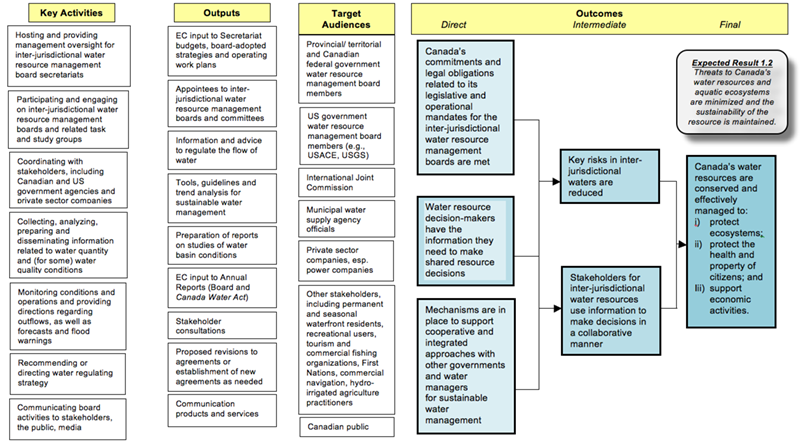Evaluation of Water Resource Management and Use program: chapter 10
Annex 1Program Logic Model
Developed to support the evaluation of Water Resource Management and Use, 2013-14 - not approved for other purposes.

Description of Annex 1: Program Logic Model
Annex 1 shows the program logic model for the Water Resource Management and Use program that was developed to support the evaluation. The logic model is a graphical depiction of how the activities and outputs associated with EC’s participation in water management boards relate to direct, intermediate, and final outcomes. Program activities lead to outputs directed at target audiences, which in turn lead to direct outcomes, then to immediate outcomes, and eventually to the final outcomes.
Key Activities:
- Hosting and providing management oversight for inter-jurisdictional water resource management board secretariats
- Participating and engaging on inter-jurisdictional water resource management boards and related task and study groups
- Coordinating with stakeholders, including Canadian and US government agencies, private sector companies
- Collecting, analyzing, preparing and disseminating information related to water quantity and (for some), water quality, conditions
- Monitoring conditions and operations and providing directions regarding outflows, as well as forecasts and flood warnings
- Recommending or directing water regulating strategy
- Communicating board activities to stakeholders, the public, media
Outputs:
- EC input to Secretariat budgets, Board adopted strategies and operating work plans
- Appointees to inter-jurisdictional water resource management boards and committees
- Information and advice to regulate the flow of water
- Tools, guidelines and trend analysis for sustainable water management
- Preparation of reports on studies of water basin conditions
- EC input to Annual Reports (Board & Canada’s Water Act)
- Stakeholder consultations
- Proposed revisions to agreements or establishment of new agreements as needed
- Communication products and services
Target Audiences
- Provincial/ territorial and Canadian federal government water resource management board members
- US government water resource management board members (e.g., USACE, USGS)
- International Joint Commission
- Municipal water supply agency officials
- Private sector companies, esp. power companies
- Other stakeholders, including permanent and seasonal waterfront residents, recreational users, tourism & commercial fishing organizations, First Nations, commercial navigation, hydro-irrigated agriculture practitioners
- Canadian public
Direct Outcomes:
- Canada’s commitments and legal obligations related to its legislative and operational mandates for the inter-jurisdictional water resource management boards are met
- Water resource decision-makers have the information they need to make shared resource decisions
- Mechanisms are in place to support cooperative and integrated approaches with other governments and water managers
- for sustainable water management
Intermediate Outcomes:
- Key risks in inter-jurisdictional waters are reduced
- Stakeholders for inter-jurisdictional water resources use information to make decisions in a collaborative manner
Final Outcomes:
- Expected Result 1.2 - Threats to Canada’s water resources and aquatic ecosystems are minimized and the sustainability of the resource is maintained.
- Canada’s water resources are conserved and effectively managed to:
- i) protect ecosystems,
- ii) protect the health and property of citizens, and
- iii) support economic activities